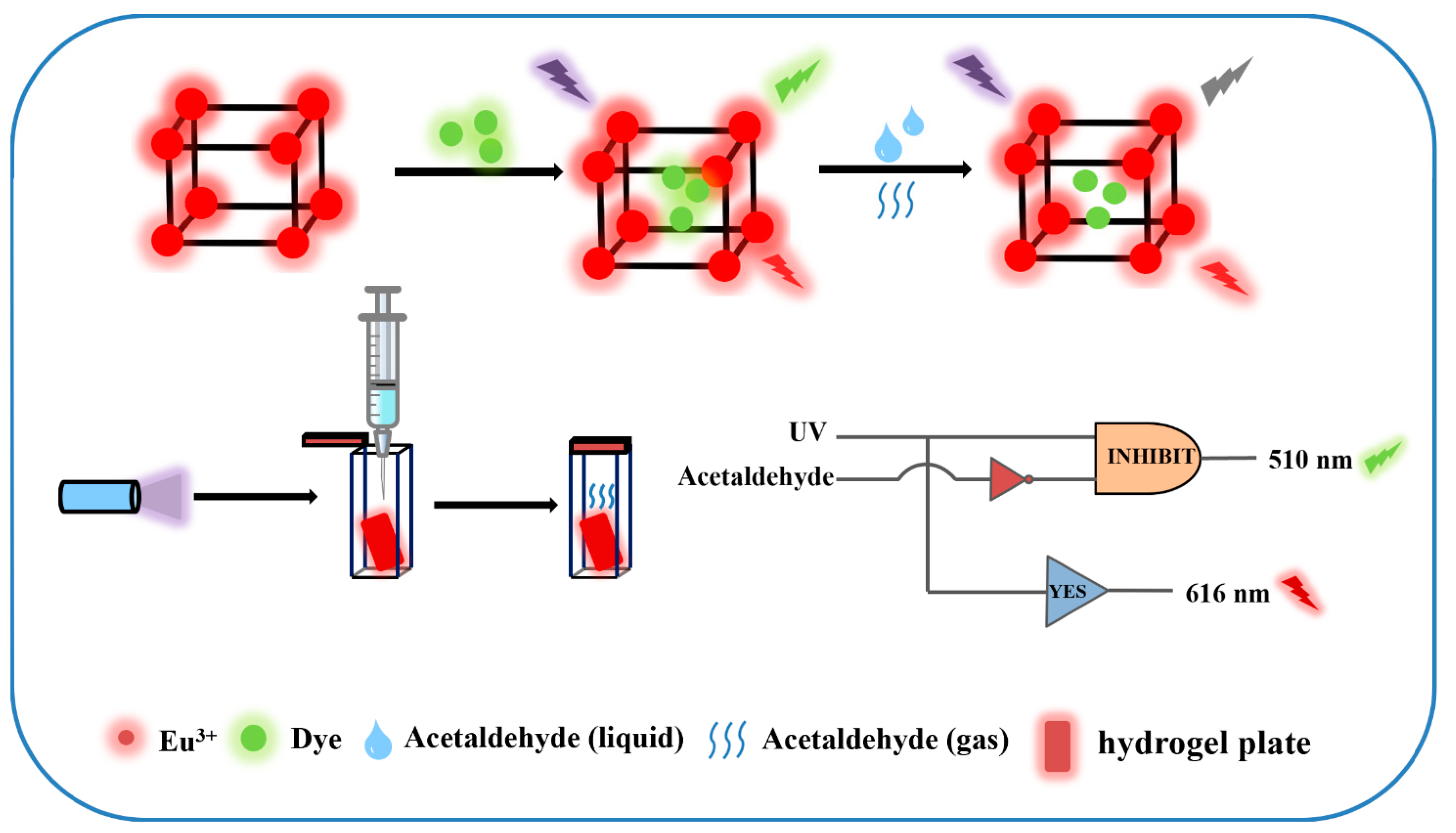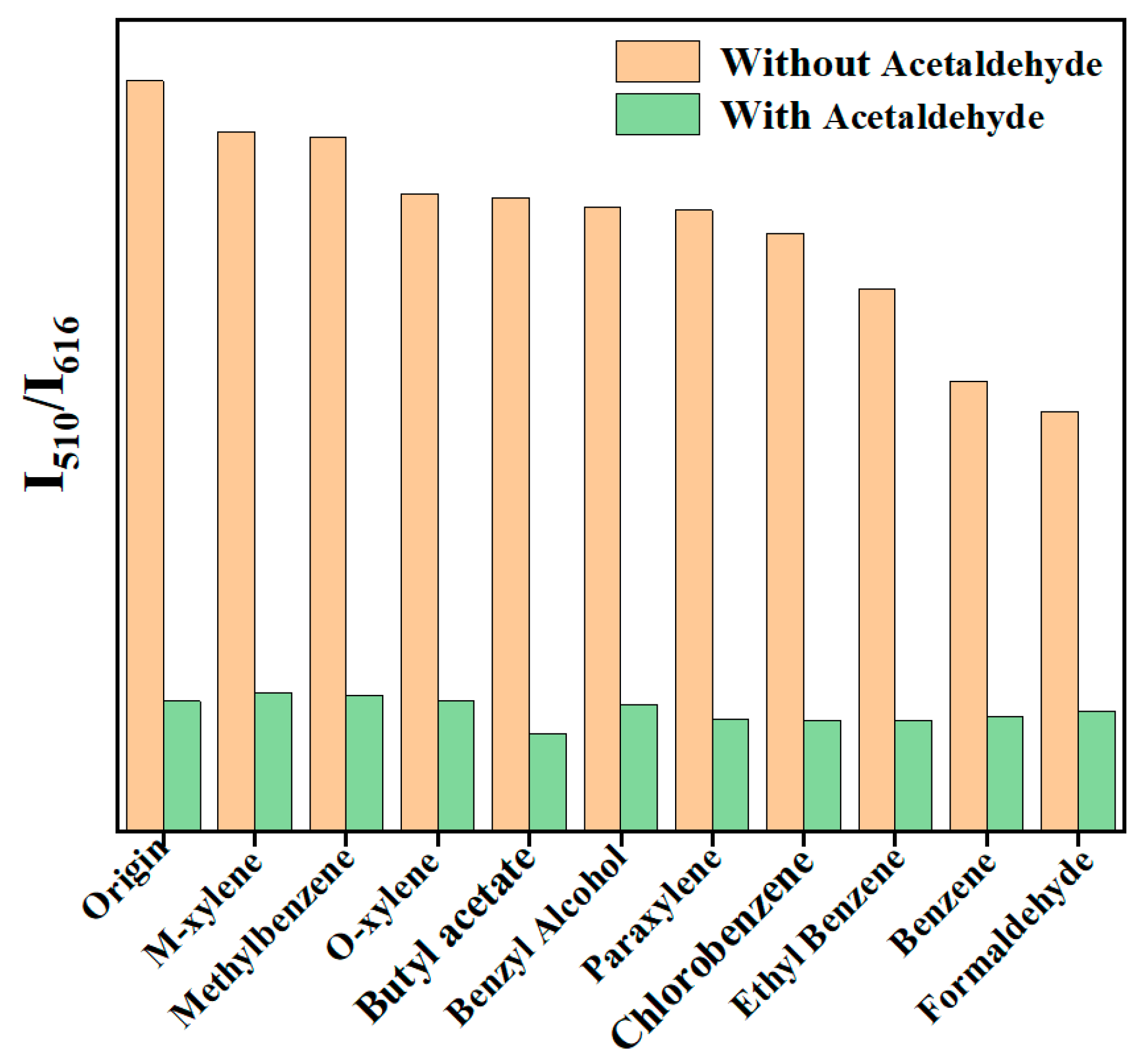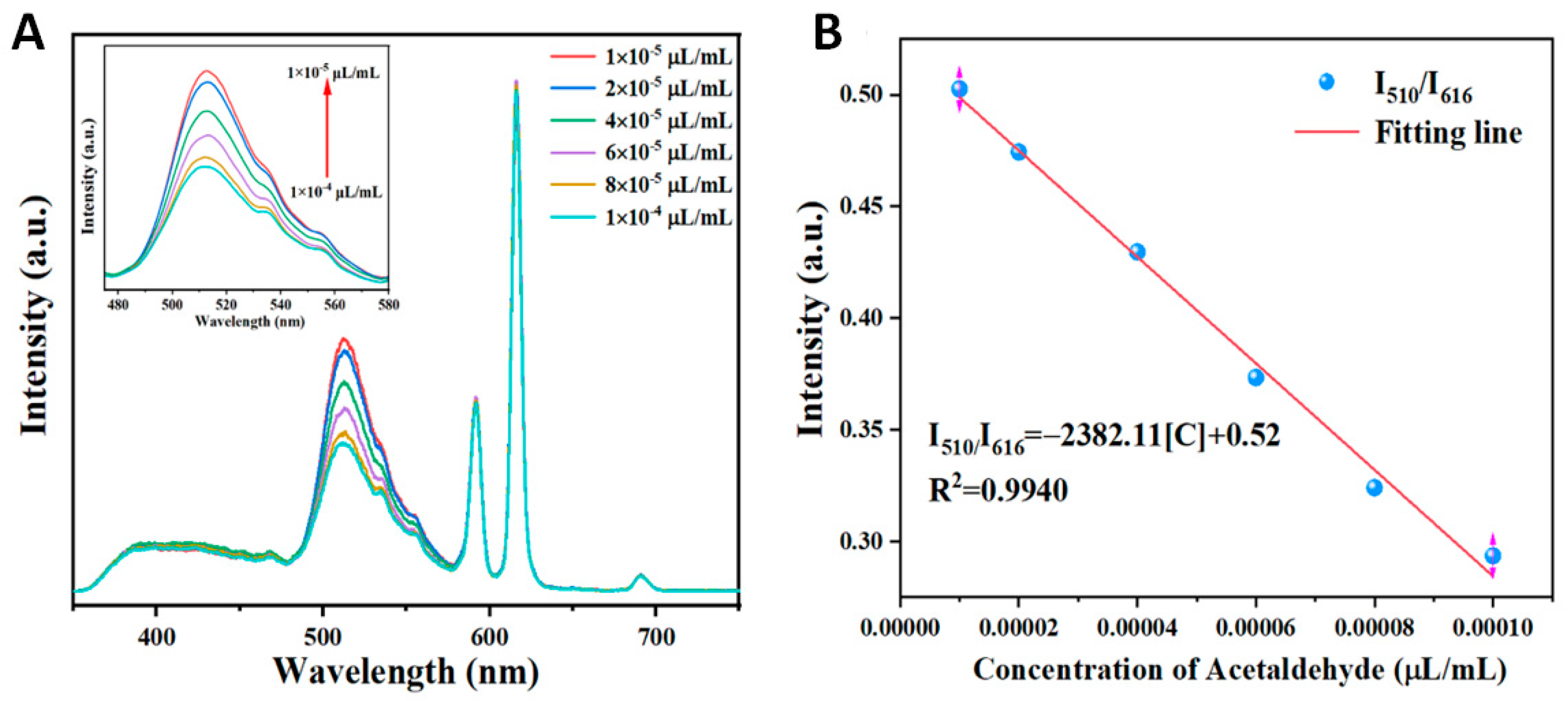A Ratiometric Fluorescent Probe Dye-Functionalized MOFs Integrated with Logic Gate Operation for Efficient Detection of Acetaldehyde
Abstract
1. Introduction
2. Results and Discussion
2.1. Composition and Structure Analysis
2.2. Fluorescent Properties of Dye@Eu-MOFs
2.3. Fluorescence Sensing of Liquid and Gaseous Acetaldehyde
2.4. Possible Mechanism of Dye@Eu-MOFs for Acetaldehyde
2.5. Construction of Logical Systems
3. Materials and Methods
3.1. Materials and Reagents
3.2. Preparation of Eu-MOFs (Namely Eu(TMA)(H2O)6)
3.3. Preparation of Dye@Eu-MOFs
3.4. Dye@Eu-MOF Composites for Detection of Acetaldehyde Liquids
3.5. Dye@Eu-MOF Composites for Real-Time Visual Detection of Acetaldehyde Gas
4. Conclusions
Supplementary Materials
Author Contributions
Funding
Institutional Review Board Statement
Informed Consent Statement
Data Availability Statement
Conflicts of Interest
References
- Epping, R.; Koch, M. On-Site Detection of Volatile Organic Compounds (VOCs). Molecules 2023, 28, 1598. [Google Scholar] [CrossRef] [PubMed]
- Yuan, M.-H.; Kang, S.; Cho, K.-S. A review of phyto- and microbial-remediation of indoor volatile organic compounds. Chemosphere 2024, 359, 142120. [Google Scholar] [CrossRef] [PubMed]
- Meng, F.; Yuan, Z.; Meng, D. Chemical Sensors for Volatile Organic Compound Detection. Chemosensors 2023, 11, 553. [Google Scholar] [CrossRef]
- Khatib, M.; Haick, H. Sensors for Volatile Organic Compounds. ACS Nano 2022, 16, 7080–7115. [Google Scholar] [CrossRef] [PubMed]
- Tang, Y.; Kong, X.; Liu, Z.-R.; Xu, A.; Lin, W. Lysosome-Targeted Turn-On Fluorescent Probe for Endogenous Formaldehyde in Living Cells. Anal. Chem. 2016, 88, 9359–9363. [Google Scholar] [CrossRef] [PubMed]
- Deng, B.; Ding, L.; Yang, S.; Tian, H.; Sun, B. A dual-function fluorescent probe for the detection of pH values and formaldehyde. Luminescence 2023, 38, 1647–1653. [Google Scholar] [CrossRef] [PubMed]
- Zhang, R.-K.; Wang, D.; Wu, Y.-J.; Hu, Y.-H.; Chen, J.-Y.; He, J.-C.; Wang, J.-X. A Cataluminescence Sensor Based on NiO Nanoparticles for Sensitive Detection of Acetaldehyde. Molecules 2020, 25, 1097. [Google Scholar] [CrossRef] [PubMed]
- Yoo, R.; Li, D.; Rim, H.J.; Cho, S.; Lee, H.-S.; Lee, W. High sensitivity in Al-doped ZnO nanoparticles for detection of acetaldehyde. Sens. Actuators B 2018, 226, 883–888. [Google Scholar] [CrossRef]
- Luong, J.; Yang, X.; Hua, Y.; Yang, P.; Gras, R. Gas Chromatography with In Situ Catalytic Hydrogenolysis and Flame Ionization Detection for the Direct Measurement of Formaldehyde and Acetaldehyde in Challenging Matrices. Anal. Chem. 2018, 90, 13855–13859. [Google Scholar] [CrossRef]
- Xiao, Z.; Zhao, L.; Tian, L.; Wang, L.; Zhao, J.-y. GC–FID determination of tetramethylpyrazine and acetoin in vinegars and quantifying the dependence of tetramethylpyrazine on acetoin and ammonium. Food Chem. 2018, 239, 726–732. [Google Scholar] [CrossRef]
- Kim, K.-H.; Pal, R. Determination of acetaldehyde in ambient air: Comparison of thermal desorption-GC/FID method with the standard DNPH-HPLC method. Environ. Monit. Assess. 2009, 161, 295–299. [Google Scholar] [CrossRef] [PubMed]
- Tian, J.; Yu, J.; Chen, X.; Zhang, W. Determination and quantitative analysis of acetoin in beer with headspace sampling-gas chromatography. Food Chem. 2009, 112, 1079–1083. [Google Scholar] [CrossRef]
- McGuigan, M.; Chapman, G.; Lewis, E.; Watson, C.H.; Blount, B.C.; Valentin-Blasini, L. High-Performance Liquid Chromatography–Tandem Mass Spectrometry Analysis of Carbonyl Emissions from E-Cigarette, or Vaping, Products. ACS Omega 2022, 7, 7655–7661. [Google Scholar] [CrossRef] [PubMed]
- Su, Y.; Yu, J.; Li, Y.; Phua, S.F.Z.; Liu, G.; Lim, W.Q.; Yang, X.; Ganguly, R.; Dang, C.; Yang, C.; et al. Versatile bimetallic lanthanide metal-organic frameworks for tunable emission and efficient fluorescence sensing. Commun. Chem. 2018, 1, 12. [Google Scholar] [CrossRef]
- Feng, L.; Dong, C.; Li, M.; Li, L.; Jiang, X.; Gao, R.; Wang, R.; Zhang, L.; Ning, Z.; Gao, D.; et al. Terbium-based metal-organic frameworks: Highly selective and fast respond sensor for styrene detection and construction of molecular logic gate. J. Hazard. Mater. 2020, 388, 121816. [Google Scholar] [CrossRef] [PubMed]
- Zhai, X.; Kou, Y.; Liang, L.; Liang, P.; Su, P.; Tang, Y. AIE Ligand-Based Luminescent Ln-MOFs for Rapid and Selective Sensing of Tetracycline. Inorg. Chem. 2023, 62, 18533–18542. [Google Scholar] [CrossRef] [PubMed]
- Cui, Y.; Chen, F.; Yin, X.-B. A ratiometric fluorescence platform based on boric-acid-functional Eu-MOF for sensitive detection of H2O2 and glucose. Biosens. Bioelectron. 2019, 135, 208–215. [Google Scholar] [CrossRef] [PubMed]
- Che, J.; Jiang, X.; Fan, Y.; Li, M.; Zhang, X.; Gao, D.; Ning, Z.; Li, H. A novel dual-emission fluorescence probe based on CDs and Eu3+ Functionalized UiO-66-(COOH)2 hybrid for visual monitoring of Cu2+. Materials 2022, 15, 7933. [Google Scholar] [CrossRef] [PubMed]
- Li, Y.; Wei, Z.; Zhang, Y.; Guo, Z.; Chen, D.; Jia, P.; Chen, P.; Xing, H. Dual-Emitting EY@Zr-MOF Composite as Self-Calibrating Luminescent Sensor for Selective Detection of Inorganic Ions and Nitroaromatics. ACS Sustain. Chem. Eng. 2019, 7, 6196–6203. [Google Scholar] [CrossRef]
- Yin, H.-Q.; Yang, J.-C.; Yin, X.-B. Ratiometric Fluorescence Sensing and Real-Time Detection of Water in Organic Solvents with One-Pot Synthesis of Ru@MIL-101(Al)–NH2. Anal. Chem. 2017, 89, 13434–13440. [Google Scholar] [CrossRef]
- Zheng, H.; Zhan, X.-Q.; Bian, Q.-N.; Zhang, X.-J. Advances in modifying fluorescein and rhodamine fluorophores as fluorescent chemosensors. Chem. Commun. 2013, 49, 429–447. [Google Scholar] [CrossRef] [PubMed]
- Zhang, Y.-Q.; Wu, X.-H.; Mao, S.; Tao, W.-Q.; Li, Z. Highly luminescent sensing for nitrofurans and tetracyclines in water based on zeolitic imidazolate framework-8 incorporated with dyes. Talanta 2019, 204, 344–352. [Google Scholar] [CrossRef] [PubMed]
- Li, Q.; Li, D.; Wu, Z.-Q.; Shi, K.; Liu, T.-H.; Yin, H.-Y.; Cai, X.-B.; Fan, Z.-L.; Zhu, W.; Xue, D.-X. RhB-Embedded Zirconium–Biquinoline-Based MOF Composite for Highly Sensitive Probing Cr(VI) and Photochemical Removal of CrO42–, Cr2O72–, and MO. Inorg. Chem. 2022, 61, 15213–15224. [Google Scholar] [CrossRef] [PubMed]
- Cao, Q.; Yu, Q.; Li, Z.; Huang, Z.; Jia, Q. Rhodamine B functionalized luminescent metal-organic frameworks for ratiometric fluorescence sensing of hydroquinone. J. Mater. Chem. B 2022, 10, 8295–8301. [Google Scholar] [CrossRef] [PubMed]
- Zheng, X.; Zhao, Y.; Jia, P.; Wang, Q.; Liu, Y.; Bu, T.; Zhang, M.; Bai, F.; Wang, L. Dual-Emission Zr-MOF-Based Composite Material as a Fluorescence Turn-On Sensor for the Ultrasensitive Detection of Al3+. Inorg. Chem. 2020, 59, 18205–18213. [Google Scholar] [CrossRef] [PubMed]
- Xu, N.; Tang, Z.; Jiang, Y.-P.; Fang, J.; Zhang, L.; Lai, X.; Sun, Q.-J.; Fan, J.-M.; Tang, X.-G.; Liu, Q.-X.; et al. Highly Sensitive Ratiometric Fluorescent Flexible Sensor Based on the RhB@ZIF-8@PVDF Mixed-Matrix Membrane for Broad-Spectrum Antibiotic Detection. ACS Appl. Mater. Interfaces 2023, 15, 52993–53002. [Google Scholar] [CrossRef] [PubMed]
- Wang, X.R.; Wang, X.Z.; Du, J.; Huang, Z.; Liu, Y.Y.; Huo, J.Z.; Liu, K.; Ding, B. Post-synthetic dual-emission rhodamine B@ZIF-365 hybrid material and Enzymatic Biosensor Enzyme@ZIF-365: Ratiometric temperature sensing, Biomolecule Nicotinamide Detection and Sensing Platform for Lactose and Al3+. J. Solid State Chem. 2019, 279, 120949. [Google Scholar] [CrossRef]
- Wang, H.; Li, Y.; Ning, Z.; Huang, L.; Zhong, C.; Wang, C.; Liu, M.; Lai, X.; Gao, D.; Bi, J. A novel red phosphor LixNa1-xEu(WO4)2 solid solution: Influences of Li/Na ratio on the microstructures and luminescence properties. J. Lumin. 2018, 201, 364–371. [Google Scholar] [CrossRef]
- Zhang, X.; Gao, J.; Chu, Q.; Lyu, H.; Xie, Z. Specific recognition and determination of trace phthalic acid esters by molecularly imprinted polymer based on metal organic framework. Anal. Chim. Acta 2022, 1227, 340292. [Google Scholar] [CrossRef]
- Liu, Y.; Liu, C.; Xu, X.; Niu, C.; Wang, J.; Zheng, F.; Li, Q. Development of a Rapid and Sensitive Fluorescence Sensing Method for the Detection of Acetaldehyde in Alcoholic Beverages. Foods 2022, 11, 3450. [Google Scholar] [CrossRef]
- Liang, B.; Liu, Y.; Zhao, Y.; Xia, T.; Chen, R.; Yang, J. Development of bacterial biosensor for sensitive and selective detection of acetaldehyde. Biosens. Bioelectron. 2021, 193, 113566. [Google Scholar] [CrossRef] [PubMed]
- Guan, R.; Zhang, S.; Fan, X.; Shao, X.; Hu, Y.; Liu, T.; Wang, S.; Yue, Q. Construction of a Turn-off–on Fluorescent System Based On Aggregation Induced Emission of Acetaldehyde Using Carbonized Polymer dots and Tb3+. J. Fluoresc. 2022, 32, 759–770. [Google Scholar] [CrossRef] [PubMed]
- Li, W.-K.; Ding, Y.-Z.; Feng, J.-T.; Ma, Z.-Q. A novel luminescent dual-ligands europium(III) complex prepared for acetaldehyde sensitive detection. Sens. Actuators B 2020, 306, 127542. [Google Scholar] [CrossRef]
- Yang, C.; Li, Y.; Wang, J.; He, J.; Hou, H.; Li, K. Fast and highly selective detection of acetaldehyde in liquor and spirits by forming aggregation-induced emission luminogen. Sens. Actuators B 2019, 285, 617–624. [Google Scholar] [CrossRef]
- Zachut, M.; Shapiro, F.; Silanikove, N. Detecting ethanol and acetaldehyde by simple and ultrasensitive fluorimetric methods in compound foods. Food Chem. 2016, 201, 270–274. [Google Scholar] [CrossRef] [PubMed]
- Liu, W.; Zhang, Y.; Xu, B.; Chen, W.; Yao, W.; Fedin, V.P.; Gao, E. Eosin Y embedded Gd-MOF as a dual emission detection platform for dopamine. Inorg. Chem. Commun. 2024, 160, 111916. [Google Scholar] [CrossRef]
- Fan, Y.; Jiang, X.; Che, J.; Li, M.; Zhang, X.; Gao, D.; Bi, J.; Ning, Z. A Ratiometric Fluorescent Sensor Based on Dye/Tb (III) Functionalized UiO-66 for Highly Sensitive Detection of TDGA. Molecules 2022, 27, 6543. [Google Scholar] [CrossRef] [PubMed]
- Jiang, X.; Li, W.; Liu, M.; Yang, J.; Liu, M.; Gao, D.; Li, H.; Ning, Z. A Ratiometric Fluorescent Probe Based on RhB Functionalized Tb-MOFs for the Continuous Visual Detection of Fe3+ and AA. Molecules 2023, 28, 5847. [Google Scholar] [CrossRef] [PubMed]
- Song, J.; Zhao, B.; Wang, Y.; Liu, X.; Cheng, Z.; Zhang, X.; Feng, X. A portable smartphone-assisted Tb-MOF-based agar-slice probe for the rapid and on-site fluorescence assay of malachite green in aquatic products. Food Chem. 2024, 437, 137883. [Google Scholar] [CrossRef]
- Wang, X.; Li, L.; Jiang, H.; Zhangsun, H.; Wang, Q.; Sun, X.; Wang, L. Highly selective and sensitive fluorescence detection of tetracyclines based on novel tungsten oxide quantum dots. Food Chem. 2022, 374, 131774. [Google Scholar] [CrossRef]
- Liu, L.; Liu, P.; Ga, L.; Ai, J. Advances in Applications of Molecular Logic Gates. ACS Omega 2021, 6, 30189–30204. [Google Scholar] [CrossRef] [PubMed]
- Pawar, S.; Duadi, H.; Fleger, Y.; Fixler, D. Carbon Dots-Based Logic Gates. Nanomaterials 2021, 11, 232. [Google Scholar] [CrossRef] [PubMed]
- Feng, L.; Dong, C.; Jiang, W.; Gu, X.; Xiao, M.; Li, C.; Ning, Z.; Gao, D. A facile synthesized Eu-based metal–organic frameworks sensor for highly selective detection of volatile organic compounds. J. Mater. Sci. Mater. Electron. 2019, 30, 19247–19253. [Google Scholar] [CrossRef]








| Materials | Linear Range | LOD | Reference |
|---|---|---|---|
| FPN1 | 0.0053–200 mg/L | 1.6 × 10−3 mg/L | [30] |
| AldDH | 1–300 μM | 1.4 × 10−2 mg/L | [31] |
| CPDs-Tb3+ | 0.04–42.48 mM | 0.881 mg/L | [32] |
| Eu2(TPA)(MIM)4(NO3)6 | 1–1200 μM | 4.8 × 10−3 mg/L | [33] |
| COFs | 0–1000 μM | 1982 mg/L | [34] |
| NADH | 1–1000 mg/L | 0.9 mg/L | [35] |
| Dye@Eu-MOFs | 10−4~10−5 μL/mL | 8.12 × 10−4 mg/L | This work |
Disclaimer/Publisher’s Note: The statements, opinions and data contained in all publications are solely those of the individual author(s) and contributor(s) and not of MDPI and/or the editor(s). MDPI and/or the editor(s) disclaim responsibility for any injury to people or property resulting from any ideas, methods, instructions or products referred to in the content. |
© 2024 by the authors. Licensee MDPI, Basel, Switzerland. This article is an open access article distributed under the terms and conditions of the Creative Commons Attribution (CC BY) license (https://creativecommons.org/licenses/by/4.0/).
Share and Cite
Li, W.; Liu, M.; Zhao, Y.; Fan, Y.; Li, Y.; Gao, H.; Li, H.; Gao, D.; Ning, Z. A Ratiometric Fluorescent Probe Dye-Functionalized MOFs Integrated with Logic Gate Operation for Efficient Detection of Acetaldehyde. Molecules 2024, 29, 2970. https://doi.org/10.3390/molecules29132970
Li W, Liu M, Zhao Y, Fan Y, Li Y, Gao H, Li H, Gao D, Ning Z. A Ratiometric Fluorescent Probe Dye-Functionalized MOFs Integrated with Logic Gate Operation for Efficient Detection of Acetaldehyde. Molecules. 2024; 29(13):2970. https://doi.org/10.3390/molecules29132970
Chicago/Turabian StyleLi, Wenwei, Min Liu, Yourong Zhao, Yangchun Fan, Yuting Li, Hongmei Gao, Hongda Li, Daojiang Gao, and Zhanglei Ning. 2024. "A Ratiometric Fluorescent Probe Dye-Functionalized MOFs Integrated with Logic Gate Operation for Efficient Detection of Acetaldehyde" Molecules 29, no. 13: 2970. https://doi.org/10.3390/molecules29132970
APA StyleLi, W., Liu, M., Zhao, Y., Fan, Y., Li, Y., Gao, H., Li, H., Gao, D., & Ning, Z. (2024). A Ratiometric Fluorescent Probe Dye-Functionalized MOFs Integrated with Logic Gate Operation for Efficient Detection of Acetaldehyde. Molecules, 29(13), 2970. https://doi.org/10.3390/molecules29132970







